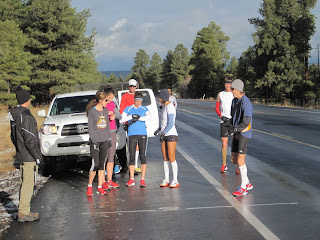Best of..."Races of 2010"
May - Sky Mesa Marathon (CO)
February - Pemberton Trail 50K (AZ)
June - Western States 100 Mile Endurance Run (CA)
April - Zane Grey Highline 50 Mile (AZ)
February - Volunteering at the Sedona Marathon (AZ)
September - the Inaugural Pine to Palm 100 Mile Endurance Run (OR)
August - Pine to Palm course scouting with the race director Hal Koerner and eventual winner Tim Olson
September - A Southern Oregon Beer Mile
August - Leadville Trail 100 Mile, pacing Hal Koerner (CO)
February - Pemberton Trail 50K, Josh Brimhall and Hal Koerner do battle for top honors.
September - Run on the Sly 50K (CA)
Best of..."Faces of 2010"
Halloween - Eric Bohn, Torrence and Brian Tinder (or is that Torrence again?)
Mesquite Canyon 50K - Tinder, Torrence, Bohn and Bret Sarnquist
A 21-mile loop in Sedona, AZ - Scott Jurek, Joe Grant, James Willis, Trent Briney, Tinder
Zane Grey Road Trip - Scott Mason, Larry O'Neil, Karl Meltzer, Torrence
Backyard BBQ
New Assistant Coaching Responsibilities - Tracy and Greg McMillan, Torrence
A Winter Grand Canyon Trip with Nick and Jamil Coury
The Langoliers Return, JFK 50 Mile - Front: Tinder and Bohn. Rear: Eric Clifton and Torrence
The morning of Western States: Torrence, Tinder and Olson
Best of..."Scenes of 2010"
Colton Crater and the Peaks
The La Sals and Moab Slickrock
A morning run on the Kachina Trail
On top of California: White Mountain Peak
The trails outside of Kirkland, CA with my brother-in-law, Duane Miller
The Grand Canyon - The Bright Angel Trail in January
Flagstaff's Blizzard of 2010
Best of..."2010 Team USA Arizona"
Paige Higgins and Coach Greg McMillan
Andrew Middleton drafts Trent Briney on Lake Mary Road
Coming and Going: The Men & Women of Team USA Arizona
Sedona Track: Andrew Lemoncello, Brett Gotcher, Martin Fagan & Andrew Carlson
Lemoncello & Higgins
Coach McMillan records splits.
Mr. Sub-4: Jordan Horn
Carlson enjoys post US National 25K victory beverages.
Working in Buffalo Park: Lemoncello, Fasil Bizuneh, Fagan
Emily Harrison and Natasha LaBeaud on the Mountain Shadows Loop
Fasil and James Carney on the Mtn. Shadows Loop
Coach McMillan films the athletes.
Men of Team USA Arizona on a Long Run on FS Road 222.
Women of McMillanElite.
The start of a Lake Mary Road Tempo Run.
Fagan and Gotcher are off!
Another stunning day in Sedona.
Best of..."Your Moment of Zen 2010"
Caged Furry Fury
Monument Valley at Dusk
I'd rather have chicken, but this will do.
Andrew Lemoncello properly demonstrates Nintendo's new game "Guitar Puppy".
















































